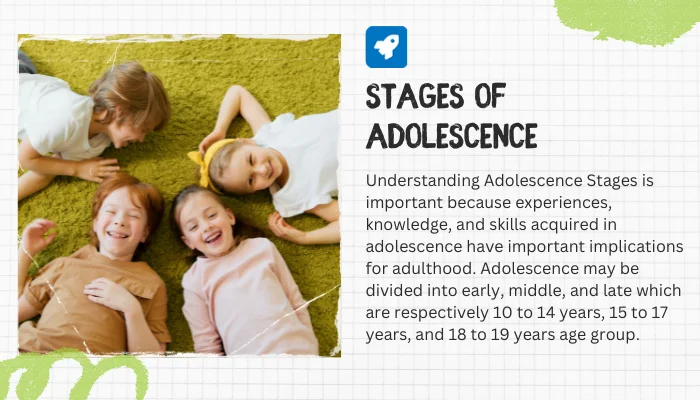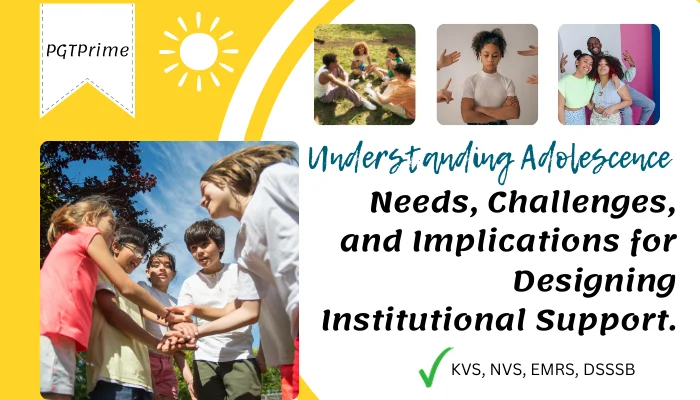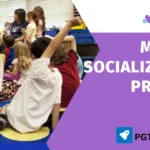Where mood swings are Olympic sports, and ‘I don’t know’ becomes the official motto.” Are you able to Guess this period of development? This we called the “Adolescence Period”.
Understanding adolescence is important because we have either been through it or are about to go through it, Experiences, knowledge, and skills acquired in adolescence have important implications for adulthood. We studied this during our B.Ed (Bachelor of Education), and this is one of the topics from B.Ed curriculum.
Life is full of tremendous energy, isn’t it? just like that adolescence is the most important period in every person’s life where he/she is no longer a child and not yet an adult. In “Growth and Development” topic of Child Development & pedagogy, we have covered a small part of adolescence and today we will be understanding Adolescence in detail. What is adolescence, its needs, challenges, stages, and implications?
Before moving forward. Just keep us motivated through your comments and request you to subscribe to our Facebook, X (formerly Twitter), or Telegram channel for all our latest updates.
Now let’s understand this topic a little better from an exam point of view because these are being asked in all central and state-level teaching exams.
Understanding Adolescence Meaning
What is adolescence? understanding Adolescence
The term adolescence is derived from the Latin word “adolescere” which means “to grow up”, growing towards maturity between childhood and adulthood. It emerges from childhood and merges into adulthood. This period Starts at the age of 12 or 13 for girls and 13 or 14 for boys and it continues up to 19.
Adolescence is defined by different intellectuals in their own way, which are as follows:
- According to Stanley Hall “Adolescence is a period of great stress, storm, and strike”.
- According to Karl Michael ” Adolescence has been defined, as that time of life when an immature individual approaches the culmination of his physical and mental growth”.
- According to Eysenck “Adolescence period is a period after Childhood in which individual self-responsibility is established”.
- According to Biggie and Hunt “one word which best characterizes adolescence is change, the change is psychological, sociological, and physical”.
- According to Aristotle “Adolescents think that they know everything and are quite sure of it”.
- World Health Organization defines “Adolescence as a phase of life between 10 to 19 years of age characterized by physical growth emotional psychological behavioral changes thus bringing about transformation from childhood to adulthood”.
These changes usually occur a year or two year earlier in girls than boys. some of changes are extremely visible and some are internal. These changes are normal natural and are due to release of various hormones in both boys and girls.
If we talk about puberty, the term “puberty” is sometimes equated with adolescence. However, both the terms are not the same. Puberty is only a small part of the larger process of adolescence. Now let us understand it.
Don’t forget to check it out: All about KVS.😜
Difference between Puberty and Adolescence
Understanding adolescence and puberty differences gives you a clear picture in your mind. Have a look:
| Aspect | Understanding Puberty | Understanding Adolescence |
|---|---|---|
| Definition | Biological processes are triggered by hormonal changes, leading to sexual maturation. | Typically, it starts around ages 9-10 for girls and 11-12 for boys. |
| Focus | Primarily physical and hormonal changes. | Includes cognitive, emotional, and social development. |
| Age Range | Typically, it starts around ages 9-10 for girls and 11-12 for boys. | Begins with the onset of puberty but can extend beyond it. |
| Physical Changes | – Growth spurts (height and weight increase). -Development of secondary sexual characteristics (e.g., breast development in girls, facial hair in boys). | – Continued growth and maturation. – Changes in body composition, brain structure, and organ systems. |
| Cognitive Changes | Not the primary focus during puberty. | Significant cognitive development: abstract thinking, impulse control, decision-making, etc. |
| Emotional Changes | Hormonal fluctuations may impact mood. | Emotional rollercoaster: self-identity, relationships, self-esteem, and coping skills. |
| Social Changes | Limited focus on social aspects. | Exploration of social roles, peer relationships, and independence. |
Don’t forget to check it out: The Hidden Gems: KVS LDCE Question Paper 2023.😜
Characteristics of Adolescence
Now, Understanding adolescence characteristics is a difficult journey characterized by contradictions fantasies surprises, and uncertainties. Just look at the points:
- Growth Spurt.
- Self-exploration and interaction.
- Physical appearance decides self-image.
- Desire for independence and prove their identity.
- Heightened self-consciousness and egocentrism.
- Emotionally unstable, unpredictable, and curious.
- Peer influence outweighs parental affection.
- Changing focus on relationships.
- Idealism and confrontation with religion tradition and moral values.
- Absence of long term thinking about life and about the world.
- Desire to be considered as an asset rather than a problem.
Don’t forget to check it out: Essential CDP Growth and Development😜
Stages of Adolescence

Understanding Adolescence Stages is important because experiences, knowledge, and skills acquired in adolescence have important implications for adulthood. Adolescence may be divided into early, middle, and late which are respectively 10 to 14 years, 15 to 17 years, and 18 to 19 years age group. and here we are trying to divide the phase according to domains of development roughly.
| Stage | Age Range | Key Characteristics |
|---|---|---|
| Early Adolescence | 10-14 years | Experience rapid physical growth. |
| Middle Adolescence | 15-17 years | Peer pressure tends to peak during this stage, appearance becomes a major concern. |
| Late Adolescence | 18-19 years | Physical development usually stabilizes during this phase, but cognitive development continues. |
Understanding Adolescence Physical Change or Development:
Let’s delve deeper into the stages of adolescence, focusing on the physical changes for both boys and girls:
Early Adolescence (10-13 years)
| Aspect | Boys – Physical Changes | Terminology | Girls – Physical Changes | Terminology |
|---|---|---|---|---|
| Growth | – Rapid growth in height and weight – Increase in limb length before torso growth | -Growth spurt | – Rapid growth in height and weight – Increase in limb length before torso growth | – Growth spurt |
| Genital Development | – Enlargement of testes and scrotum – Slight enlargement of penis | – Testicular enlargement – Penile growth | – Ovaries enlarge and become more active – Uterine growth | – Ovarian enlargement – Uterine growth |
| Hair Growth | – Appearance of light pubic hair at the base of the penis | – Pubarche | – Appearance of light pubic hair on the labia majora | – Pubarche |
| Skin Changes | – Increase in sebaceous gland activity – Acne may begin | – Seborrhea – Acne | – Increase in sebaceous gland activity – Acne may begin | – Seborrhea – Acne |
| Sweating | – Increase in sweat production | – Hyperhidrosis | – Increase in sweat production | – Hyperhidrosis |
| Voice Changes | – Early signs of voice deepening | – Initial voice changes | – N/A | – N/A |
Don’t forget to check it out: New National Education Policy (NEP 2020)😜
Middle Adolescence (14-17 years)
| Aspect | Boys – Physical Changes | Terminology | Girls – Physical Changes | Terminology |
|---|---|---|---|---|
| Growth | – Significant increase in height and muscle mass – Broadening of shoulders | – Growth spurt – Shoulder broadening | – Continued increase in height – Development of wider hips | – Growth spurt – Hip broadening |
| Genital Development | – Further enlargement of testes and penis – Onset of nocturnal emissions | – Genital maturation – Spermarche | – Continued development of internal and external reproductive organs – Onset of ovulatory cycles | – Reproductive maturation – Menarche |
| Hair Growth | – Coarsening and spreading of pubic hair – Growth of axillary (underarm) hair – Appearance of facial hair | – Pubarche – Axillary hair growth – Facial hair growth | – Coarsening and spreading of pubic hair – Growth of axillary hair | – Pubarche – Axillary hair growth |
| Skin Changes | – Increase in oil production, potentially leading to more severe acne | – Seborrhea – Acne | – Increase in oil production, potentially leading to more severe acne | – Seborrhea – Acne |
| Sweating | – Continued increase in sweat production | – Hyperhidrosis | – Continued increase in sweat production | – Hyperhidrosis |
| Voice Changes | – Voice deepening continues, leading to a more adult male pitch | – Voice deepening | – N/A | – N/A |
| Musculoskeletal | – Increase in muscle mass and strength – Development of more angular and defined features | – Muscle hypertrophy – Skeletal maturation | – Increase in body fat distribution, particularly in hips and thighs – Development of more defined body contours | – Adipose tissue redistribution |
Don’t forget to check it out: Early Childhood Care & Education (ECCE)😜
Late Adolescence (18-19/20 years)
| Aspect | Boys – Physical Changes | Terminology | Girls – Physical Changes | Terminology |
|---|---|---|---|---|
| Growth | – Final height reached as growth plates close (epiphyseal closure) | – Epiphyseal closure | – Final height reached as growth plates close (epiphyseal closure) | – Epiphyseal closure |
| Genital Development | – Full maturation of genitalia | – Genital maturation | – Full maturation of reproductive organs | – Reproductive maturation |
| Hair Growth | – Established facial hair pattern – Full development of chest and body hair | – Beard maturation – Body hair development | – Adult pattern of pubic hair – Possible slight increase in body hair | – Adult pubarche – Body hair development |
| Skin Changes | – Stabilization of oil production – Reduction in acne | – Acne reduction | – Stabilization of oil production – Reduction in acne | – Acne reduction |
| Voice Changes | – Fully mature adult male voice | – Voice maturation | – N/A | – N/A |
| Musculoskeletal | – Peak muscle mass and strength – Fully developed skeletal structure | – Peak muscle mass – Skeletal maturity | – Stabilization of body fat distribution – Final development of body contours | – Adipose tissue stabilization |
Don’t forget to check it out: Mental Health in Schools in India: A Catapult of 21st Century.😜
Understanding Adolescence Cognitive Change or Development:
| Stage | Cognitive Changes (Boys and Girls) |
|---|---|
| Early Adolescence (10-14 years) | (Concrete operational stage) -Beginning of abstract thinking – Developing ability to consider multiple perspectives – Improved problem-solving skills – Increased attention span – Beginning of metacognition (thinking about thinking) |
| Middle Adolescence (15-17 years) | (Formal operational stage ) -Enhanced abstract thinking and reasoning skills (Formal operational stage ) – Increased capacity for hypothetical-deductive reasoning – Development of complex thinking processes – Improved decision-making abilities – Increased introspection and self-analysis |
| Late Adolescence (18-19 years) | (Advanced formal operational stage) -Full development of abstract and critical thinking – Enhanced ability to plan for the future and set goals – Increased understanding of complex issues and multiple viewpoints – Improved executive functioning skills (e.g., planning, organizing, prioritizing) – Greater emotional regulation and impulse control |
Note this point! understanding Adolescence
- Puberty: A developmental phase during adolescence with physical and hormonal changes.
- Pituitary Gland: Releases hormones that start puberty.
- Adam’s Apple: A noticeable growth in males, formed by the thyroid cartilage around the larynx.
- Pharynx: Part of the throat involved in respiration and digestion, changes during puberty.
- Adrenaline: Hormone from the adrenal glands, prepares the body for stress (“fight or flight”).
- Insulin: Hormone from the pancreas, regulates blood sugar levels.
- Dopamine: Brain neurotransmitter, influences pleasure, motivation, and reward.
- Thyroxine: Hormone from the thyroid gland, regulates metabolism and energy levels.
Don’t forget to check it out: Best Possible Role of School in Achieving Aims of Education.😜
Understanding Adolescence Psychosocial Change or Development:
| Stage | Age Range |
|---|---|
| 1. Early Adolescence | 10-14 years |
| Psychosocial Changes : Early Adolescence Identity and Self-Esteem: Exploring new personal interests, questioning parental values, increased self-consciousness. Independence: Desire for more privacy and time with friends, conflict with parents over control. Peer Influence: Seeking peer approval, susceptible to peer pressure. Romantic Interests: Beginning of romantic feelings, crushes. Emotional Changes: Mood swings, emotional outbursts, increased sensitivity to criticism. | |
| 2. Middle Adolescence | 15-17 years |
| Psychosocial Changes : Middle Adolescence Identity Formation: Developing clearer sense of self, experimenting with different roles and identities. Cognitive Development: Enhanced abstract thinking, problem-solving, consideration of future consequences. Peer Relationships: Deepening friendships, more importance placed on peer relationships, peer pressure may peak. Romantic Relationships: More serious romantic relationships, exploration of sexual identity. Moral Development: Formation of personal values and ethics, increased concern for social issues. Emotional Regulation: Learning to manage emotions, seeking independence while needing support. | |
| 3. Late Adolescence | 18-19 years (can extend to mid-20s) |
| Psychosocial Changes : Late Adolescence Identity Consolidation: Establishing a stable and coherent sense of identity, solidifying personal beliefs and values. Future Orientation: Focus on career goals, education, and long-term plans. Autonomy: Greater independence from parents, making significant life decisions. Intimate Relationships: Developing deeper and more committed romantic relationships. Social Responsibility: Increased involvement in community, awareness of societal roles and responsibilities. Self-Reflection: Enhanced ability for self-reflection, understanding of own and others’ perspectives, improved emotional stability. | |
Don’t forget to check it out: Role of ICT in Education.😜
Understanding Adolescence Sexual Change or Development:
| Stage | Age Range |
|---|---|
| 1. Early Adolescence | 10-14 years |
| Sexual Changes : Early Adolescence Onset of Puberty: Start of physical sexual development, including breast development in girls and testicular enlargement in boys. Hormonal Changes: Increase in sex hormones (estrogen in girls, testosterone in boys). Sexual Awareness: Growing curiosity about sex and sexual body changes. Menstruation: Beginning of menstrual cycles in girls. Nocturnal Emissions: Start of wet dreams in boys. Masturbation: Exploration of own body, increased incidence of masturbation. | |
| 2. Middle Adolescence | 15-17 years |
| Sexual Changes : Middle Adolescence Continued Physical Development: Further development of secondary sexual characteristics (body hair, deeper voice in boys, etc.). Sexual Identity: Exploration and questioning of sexual orientation and identity. Increased Sexual Interest: Greater interest in sexual activities and romantic relationships. Sexual Behavior: Some adolescents may begin to engage in sexual activities. Contraception and STI Awareness: Beginning to understand the importance of contraception and sexually transmitted infections (STIs). | |
| 3. Late Adolescence | 18-19 years (can extend to mid-20s) |
| Sexual Changes : Late Adolescence Sexual Maturity: Full development of sexual organs and characteristics. Sexual Orientation: More stable sense of sexual orientation and identity. Intimate Relationships: Formation of more stable and committed sexual relationships. Sexual Responsibility: Increased understanding and practice of safe sex, awareness of consequences of sexual behavior. Reproductive Health: Greater awareness of reproductive health issues and regular health check-ups. Long-Term Planning: Consideration of long-term implications of sexual and reproductive choices, such as family planning. | |
Don’t forget to check it out: Insights from an Educational Philosopher .😜
Understanding Adolescence Moral Change or Development:
| Stage | Age Range |
|---|---|
| 1. Early Adolescence | 10-14 years |
| Moral Changes : Early Adolescence Moral Realism: Adherence to rules and authority, understanding morality in terms of concrete rules and consequences. Egocentric Thinking: Limited perspective-taking, understanding morality based on personal needs and desires. Peer Influence: Susceptibility to peer pressure in moral decision-making. Emerging Empathy: Beginning to understand the feelings of others, but still primarily self-focused. | |
| 2. Middle Adolescence | 15-17 years |
| Moral Changes : Middle Adolescence Moral Relativism: Understanding that rules and laws are created by people and can be changed, recognition of different viewpoints. Abstract Thinking: Ability to consider hypothetical situations and moral dilemmas. Moral Identity: Formation of personal values and principles, questioning and challenging existing moral beliefs. Increased Empathy: Greater ability to empathize with others, considering others’ perspectives in moral reasoning. Peer Influence: Peer values and norms significantly influence moral choices. | |
| 3. Late Adolescence | 18-19 years (can extend to mid-20s) |
| Moral Changes : Late Adolescence Internalized Morality: Development of a personal moral code, adherence to self-chosen ethical principles. Autonomous Moral Reasoning: Independent moral reasoning, less influenced by external authorities. Moral Complexity: Understanding the complexity of moral issues, recognizing that moral decisions can involve conflicting values. Commitment to Values: Strong commitment to personal and societal values, participation in causes and social justice issues. Moral Integrity: Striving for consistency between moral beliefs and actions, higher level of ethical behavior and responsibility. | |
Don’t forget to check it out: Master your Skills by CBSE Competency Based Education (CBE)😜
Understanding Adolescence and their needs
Understanding Adolescence- Adolescents see themselves as emerging adults and resist control from elders. Parents and teachers should grant them freedom and responsibility, treating them as individuals.
Freedom: Adolescents seek independence and autonomy, desiring the ability to make their own choices and learn from their experiences.
Self-Support: They want to develop self-reliance and the skills necessary to take care of themselves, both financially and emotionally.
Security Needs: A stable and safe environment is crucial for adolescents to feel secure and protected as they explore new aspects of their identity and world.
Social Approval: Acceptance and validation from peers and significant adults play a vital role in their self-esteem and social development.
Desire for New Experiences: Adolescents are naturally curious and seek novel and diverse experiences to broaden their horizons and foster personal growth.
Don’t forget to check it out: Case Based Learning: An Important Approach to Pedagogy.😜
Challenges of Adolescence
Understanding Adolescence Challenges through various developments. These are:
Challenges related to physical development:
Physical changes are an essential part of adolescence. These changes are part of normal process of maturation. It is a challenging process for the individual especially when these changes are early or late compared to their peers.
- Bullying by peers and comparison with peers who are developing at a different rate makes them anxious about their appearance.
- Taking poor nutrition may cause poor growth in height and anemia is a common problem in adolescence.
- Adolescents may take harmful drugs like steroids to increase their heights and muscles and suffer from their negative effects.
Challenges related to psychosexual development:
The journey of self-discovery is both stressful and anxiety-provoking for adolescents.
- Adolescents who belong to underprivileged and minority groups have difficulty in establishing personal identity.
- Exploration of personal sexuality and sexual identity leads them into serious relationships, heartbreaks, and this resulting stress.
Challenges related to cognitive development:
- Egocentricity or self-interest is the hallmark of adolescents. They feel unique and think that no one is capable of understanding them and their feelings this has important implications for counselors.
- To think and do creatively, on the other hand, invites trouble due to innovative and potentially risky experiments like rash driving, unsafe sex, taking alcohol, and drugs, etc.
Challenges related to social development:
Societal expectations can pose significant challenges for adolescents, making them vulnerable as they navigate the path to adulthood.
- Adolescents overwhelmed by societal expectations may exhibit antisocial behavior, ranging from minor delinquency to serious crimes.
- High or unrealistic parental expectations for academic or personal performance can lead to negative feelings, communication gaps, and antisocial behavior in adolescents.
- Conflicts often arise when adolescents feel their expectations in relationships with peers, parents, and society are unmet.
Don’t forget to check it out: Experiential Learning Activities: Study is fun.😜
Understanding Adolescence implications for designing institutional support
Implications are crucial for designing effective institutional support systems. Here’s how different aspects of adolescent development can inform the creation of supportive environments in schools, community programs, healthcare settings, and other institutions:
- Positive Communication with Parents: Bridge the generation gap, Encourage open dialogue, and Active listening to their thoughts and feelings without judgment.
- Peer Connections: Friendships matter: Friends become their chosen family. Foster healthy peer relationships. Peer mentoring: Older students can guide younger ones.
- Counseling Services: Emotional turbulence and Coping strategies: Teach them how to manage stress, anxiety, and conflicts.
- Age-Appropriate Sex Education: Equip them with accurate information about their changing bodies, relationships, and consent.
- Extracurricular Activities: Clubs, sports, and Arts—these shape character and build a sense of belonging. Develop Teamwork and leadership.
- Higher Education and Vocational Training: Help them explore options aligned with their passions.
- Internship and Apprenticeship Opportunities: Real-world skills: Internships provide a taste of professional life.
- Mental Health Support: Adulting isn’t always easy: Anxiety, stress, and transitions are there, they need Mental support.
Don’t forget to check it out: National Curriculum Framework 2023 (NCF 2023).😜
Please let us know through the comment section if you want any topic to be discussed in this blog. We will try to provide an article on that subject as early as possible.
Please leave your valuable comment in the comment box! Your comments are valuable to us.











